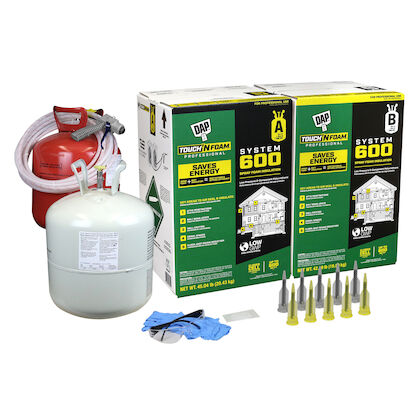
How to Seal Your Attic
The list of benefits to why you should insulate your attic could go on and on. Follow these three tips for insulating the major surfaces and structures within your attic.

-
How to Seal Your Attic
How to Seal Your Attic
The list of benefits to why you should insulate your attic could go on and on. One of the most important reasons, however, is to avoid any gradual damage to your home caused by heat and moisture.
The Touch ‘n Foam Professional line of Pro Sealants offer a number of products for insulating and sealing various areas of a typical attic. Our 2-component spray foam insulation kits are ideal for insulating large areas like attic floors and walls. Ready-to-use sealants and gun foams are ideal for sealing hatches, soffits, large gaps and HVAC, electrical and plumbing penetrations. Follow these three tips for insulating the major surfaces and structures within your attic:

Floor and Wall Junctures:
Air infiltration along the top wall plate at edge of the attic causes heating/cooling loss and adds energy expense. Spray insulating foam sealant to cover edges of wall plate where it meets attic floor and joists to stop air infiltration, block pests and reduce energy costs.

Hatch:
Attic hatch doors are a common point of heat/cooling loss, causing higher energy bills. Remove loose insulation. Spray a bead of foam sealant or gun foam to fill perimeter gap. Let cure before closing door. Spray foam on outer edges of attic hatch assembly to seal exposed seams with studs and joists.

HVAC or Electrical Penetrations:
Heating and air conditioning ducts in attics penetrate living areas, creating gaps around duct boots and grill plates that result in unwanted air infiltration. Spray foam sealant around HVAC boots where they penetrate the drywall below. Also, spray foam where flexible ducts connect to the penetrating boot.

-
Recommended Products
Product Recommendations

DAP Touch 'n Foam Low GWP System 200 Foam Insulation Kit
A portable, disposable foam insulation kit with quick-drying properties and fire-rated features, perfect for enhancing R-value and air sealing.
View Product
Touch ‘n Foam® Professional Low GWP Foam Kit 600 1.75 PCF FR
Touch ‘n Foam System 600 is a completely self-contained two-component foam system that is portable and disposable.
View Product -
Featured Projects
Featured Projects
![]()
How to Insulate Your Rim Joists and Stud Wall Cavities
Want to make your home more energy efficient? Try one of the most effective methods: insulating with spray foam.
Read More![Lower Your Energy Bills By Weatherizing Your Home How To Seal Windows And Doors Landing Page]()
Lower Your Energy Bills by Weatherizing Your Home
Learn how to seal air leaks in order to weatherize your home. Properly sealing windows and doors not only prevents unwanted drafts, but also protects against damage from the elements. What’s more, it helps increase heating efficiency to put money back into your wallet.
Read More![]()
6 Important Places to Seal Around Your Home with Foam
There are a variety of places around a home that drafts, pests, moisture, etc., can enter. Take action now and thank yourself later by following these 6 tips.
Read More![]()
How to Insulate Wall Cavities
Wood stud walls above grade or in basements typically provide numerous entry points for air and moisture infiltration. Touch ‘n Foam Pro spray foam insulates stud wall cavities up to a 2 inch fill to create a barrier that is virtually impermeable.
Read More

 USA - EN
USA - EN Canada - EN
Canada - EN


